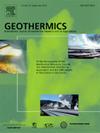机器学习与深度学习相结合的遥感地热探测研究——以黄冈市为例
IF 3.5
2区 工程技术
Q3 ENERGY & FUELS
引用次数: 0
摘要
能源科学极大地推动了社会进步,利用可再生能源已成为普遍共识。其中,地热能具有绿色、环保、高效、稳定、利用率高等优点。然而,地热资源的探测具有很大的不确定性。遥感(RS)数据和人工智能(AI)在克服这些挑战方面展现出了巨大的潜力。为了实现地热探测,本研究设计了一种基于遥感和人工智能的地热探测方法,其中考虑了与遥感相关的各种地热因素,包括地表温度、磁异常、重力异常、与断层和河流的距离、夜间光线、土地利用类型、地貌、岩性等。检测过程分为两个阶段:使用机器学习(ML)方法进行粗检测,如信息模型(IM)、人工神经网络(ANN)、逻辑回归(LR)、单类支持向量机(OCSVM)、支持向量机(SVM)和随机森林(RF)。然后,利用多通道 U 型深度学习网络(MUnet)将粗粒度地热检测结果与细粒度检测结果相结合,以实现高质量的检测。以黄冈市为研究区域,结果表明:(1) RS 相关地热因子对地热分布有显著影响,通过 ML 模型中的特征权重分析,可有效识别并量化这些因子的非线性关系。射频模型通过突出这些关键因素,在粗粒度检测中表现最佳,但其地热单元面积比(GDA)仍然高达 24.43%,将 4262 平方公里的研究区域划分为地热单元,导致很大的假阳性率。(2)细粒度检测模型 MUnet 能够捕捉与 RS 有关的地热因子的局部空间效应,F1 得分高达 90.91 %,GDA 大幅降低至 2.82 %,凸显了其在识别地热区域方面的卓越灵敏度。通过从多通道输入中提取特征和逐步解码的结构化过程,MUnet 生成了高度精确的检测结果。(3) RF-MUnet 组合方法通过整合两种模型的优势,进一步提高了检测精度,实现了与 RS 相关的地热因素对地热分布影响的本地化学习。它超越了独立的 RF 和 MUnet 模型,取得了 92.47 % 的 F1 分数和 1.94 % 的 GDA 分数。这表明 RF-MUnet 可以提供全面可靠的地热探测结果,从而以较高的经济效益进行大规模地热资源勘探,并有助于后续更精确的地球化学和地球物理测量。本文章由计算机程序翻译,如有差异,请以英文原文为准。
Geothermal detection study using remote sensing data by combining machine learning and deep learning: A case study of Huanggang City
Energy science has significantly advanced societal progress, and the use of renewable energy has become a universal consensus. Among these, geothermal energy offers the advantages of being green, environmentally friendly, efficient, stable, and highly utilized. However, detecting geothermal resources involves significant uncertainty. Remote sensing (RS) data and artificial intelligence (AI) have shown immense potential in overcoming these challenges. To achieve geothermal detection, this study designs a geothermal detection method based on RS and AI, taking into account various RS-related geothermal factors, including land surface temperature, magnetic anomaly, gravity anomaly, distance to faults and rivers, nighttime light, land use type, landform, lithology, and more. The detection process is divided into two stages: coarse detection using machine learning (ML) methods such as the Information Model (IM), Artificial Neural Network (ANN), Logistic Regression (LR), One-Class Support Vector Machine (OCSVM), Support Vector Machine (SVM), and Random Forest (RF). Then, the coarse geothermal detection results are combined with fine-grained detection using a Multi-channel U-shaped Deep Learning Network (MUnet) to achieve high-quality detection. Taking Huanggang City as the research area, the results demonstrate that (1) RS-related geothermal factors significantly influence geothermal distribution, with their nonlinear relationships effectively identified and quantified through feature weight analysis in ML models. The RF model exhibits the best performance in coarse detection by highlighting these key factors, but its Area Ratio of Geothermal Units (GDA) remains high at 24.43 %, classifying 4262 km² of the study area as geothermal units, leading to a substantial false positive rate. (2) The fine-grained detection model MUnet excels by capturing the local spatial effects of RS-related geothermal factors, achieving an F1 score of 90.91 % and dramatically reducing the GDA to 2.82 %, which underscores its exceptional sensitivity in identifying geothermal regions. Through a structured process of feature extraction and progressive decoding from multi-channel inputs, MUnet generates highly precise detection results. (3) The combined RF-MUnet method further enhances detection precision by integrating the strengths of both models, enabling localized learning of RS-related geothermal factors’ effects on geothermal distribution. It surpasses standalone RF and MUnet models, achieving an F1 score of 92.47 % and a GDA of 1.94 %. This indicates that RF-MUnet can provide comprehensive and reliable geothermal detection results, enabling large-scale geothermal resource exploration with high economic efficiency and assisting in subsequent more precise geochemical and geophysical measurements.
求助全文
通过发布文献求助,成功后即可免费获取论文全文。
去求助
来源期刊

Geothermics
工程技术-地球科学综合
CiteScore
7.70
自引率
15.40%
发文量
237
审稿时长
4.5 months
期刊介绍:
Geothermics is an international journal devoted to the research and development of geothermal energy. The International Board of Editors of Geothermics, which comprises specialists in the various aspects of geothermal resources, exploration and development, guarantees the balanced, comprehensive view of scientific and technological developments in this promising energy field.
It promulgates the state of the art and science of geothermal energy, its exploration and exploitation through a regular exchange of information from all parts of the world. The journal publishes articles dealing with the theory, exploration techniques and all aspects of the utilization of geothermal resources. Geothermics serves as the scientific house, or exchange medium, through which the growing community of geothermal specialists can provide and receive information.
 求助内容:
求助内容: 应助结果提醒方式:
应助结果提醒方式:


